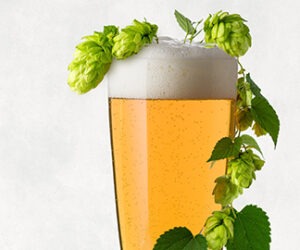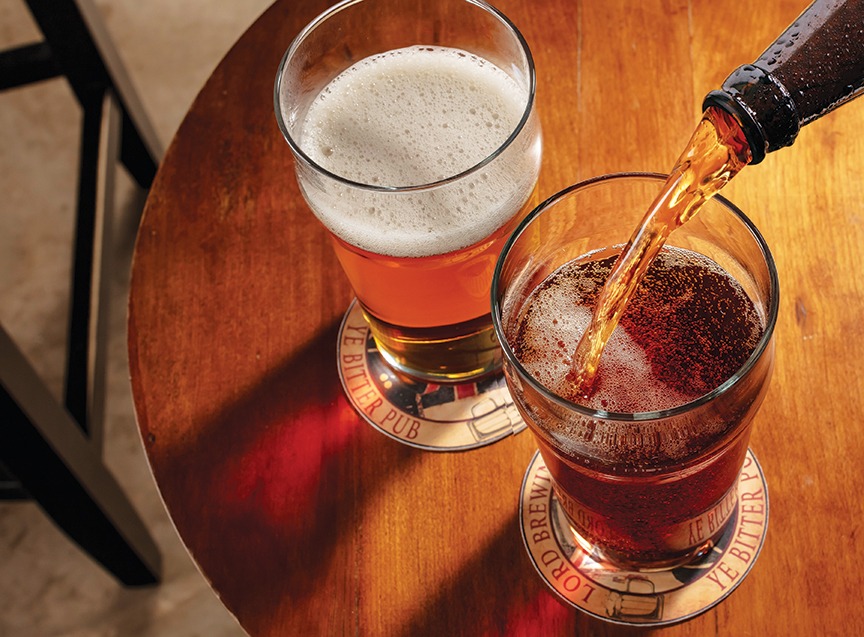German Pilsener
The Pils — short for Pilsner or Pilsener — is the northern German adaptation of the world’s first-ever blond lager, the original Czech Plzensky Prazdroj, which is more commonly known by its German name of Pilsner Urquell. The Plzensky Prazdroj was first brewed in 1842, in the Bohemian city of Plzen (Pilsen), by the Mestansky Pivovar (Burgher Brewery). This golden-blond Czech Pilsner is rich and mellow on the palate from Pilsen’s extremely soft water, Moravia’s aromatic malt, and Zatec’s (Saaz’) floral hops. On the other hand, the German interpretation of this soft and rounded lager is paler, edgy, and more assertive, in part because of the use of spicier, citrusy hops for bittering and the harder German water, which accentuates hop bitterness. To distinguish German-made from Czech-made Pilsners, many German breweries add a middle “e” to the beer’s name: Pilsener. This is also in line with strict German grammatical rules, according to which the adjective Pilsner denotes an item from Pilsen, whereas the adjective Pilsener denotes anything that resembles an item from Pilsen but is not from there.
The original Pilsner Urquell was invented by Josef Groll, a Bavarian brewmaster who was hired by the Burgher Brewery with the explicit mission to improve the quality of the local brew, which, according to contemporary records, must have been rather poor. Groll’s blond lager owes its German name to the fact that, in those days, Bohemia was part of the German-speaking Austro-Hungarian Empire. “Ur” is German for “original;” and “Quell,” for “source,” “spring,” or “well.” The new beer was an instant sensation and, in short order, became a Czech export hit throughout all of Europe. Not surprisingly, almost every brewery in the world soon imitated Pilsner. Even the standard American lager — including, for instance, Budweiser, Miller, and Pabst — are distant adaptations of Groll’s Bohemian brew. In Germany, the first indigenous Pilsner-like beer appeared on the market in 1872. It was made by the Aktienbrauerei Zum Bierkeller (the “Beer Cellar Corporation”), in the village of Radeberg, near Dresden, the capital of Saxony, a state that borders what is now the Czech Republic. This erstwhile “beer cellar” has since been renamed Radeberger and is now Germany’s largest brewing group. Today, with very few exceptions, every one of Germany’s roughly 1,300 breweries makes a Pils; and the Pils style holds a more than 50% market share in that country.
Northern German Pilseners rank among the palest beers in the world. A brew simply could not get much paler without the use of adjuncts. Once primarily a specialty of the northern German states, Pilsener is now brewed throughout the entire country, including in Bavaria where the classic indigenous blond lager is Helles. As a rule, Pils interpretations tend to become paler, drier, and bitterer as you move north from the Alps to the sea. The most authentic traditional Pils versions have a distinct, up-front hop kick from as many as 45 IBUs, while many mass-produced modern versions, nowadays, have a much reduced bitterness of as low as 23 IBUs.
An authentic Pils is always drier, crisper, more attenuated, and more refreshing in the finish than a classic Bohemian Pilsner. It has next to no fruitiness, esters, or diacetyl; and the body is medium. Its effervescence should be spritzy — more so than that of a Bohemian Pilsner — from a generous dose of carbonation of at least 5 grams of CO2 per liter (2.53 volumes of CO2), as measured at 50 °F (10 °C). Homebrewers can achieve this effervescence by priming a 5-gallon (19-L) batch with about 7.25 oz. (200 grams or 1 cup) of corn sugar. When a well-lagered Pils is poured correctly — into a tall, tulip-shaped glass, in three increments, slowly, over two minutes — it should have a sturdy, long-lasting head.
Malt
In a simple German lager such as a Pilsener, malt quality is of utmost importance. Therefore, select only the most homogeneous malt from the most malt-aromatic brewing barley varieties. A Pilsener can be made from up to 100% Pilsner malt. However, the recipe on page 53 also calls for 10% Carafoam® for some extra body and mouthfeel. For Pilsner base malt, a brewer has several choices. Virtually any malting company now offers a Pilsner malt, usually with a color of roughly 2 to 2.5 °L. For an extremely pale brew, you can use Weyermann Extra Pale Pilsner Malt, which has an unusually low average Lovibond rating of only 1.5 °L.
Other interesting base malt alternatives are a floor-malted Bohemian Pilsner malt from Weyermann or the recently introduced Barke® Pilsner Malt, also from Weyermann. Barke® is considered one of the “maltiest” two-row barley varieties ever, with some of the best properties for malting and brewing. It has a relatively large and homogeneous kernel diameter (“plumpness”), good germination potential, superior diastatic power, and low beta-glucan levels, as well as excellent extract yield and attenuation potentials.
The bittering hop for Pilsener must be assertive but not harsh or excessively citrusy. The grapefruit-like Cascade, for instance, would be totally out of place in a Pils. Instead, traditional German Tettnanger is an ideal bittering choice for Pils because it has a slightly lemony aspect and a mild touch of hay. Significantly, Tettnanger has a relatively low percentage of harsh-tasting cohumulones (only about 22–28% of total alpha-acids). Compare that to Cascade, which weighs in at a hefty cohumulone value of 33–40% of total alpha-acids. For reference, one of the highest concentrations of cohumulone in hops is in Brewers Gold at 40–48% of total alpha-acids.
Low cohumulone levels are especially important in the highly drinkable, high-IBU Pils, which requires a slightly astringent yet still pleasant bitterness. In addition, high cohumulone levels have a detrimental effect on head retention. In a classic German Pils, therefore, which requires a strong, creamy-white head as a style-defining characteristic, cohumulones are the least desirable alpha-acids.
The hop selected as a flavor variety in our recipe is the almost Saaz-like German Spalt. The hop fits a Pils perfectly, because it has not only a very low cohumulone content (only 22– 29% of total alpha-acids), but also has a substantial amount of fragrant humulene oil (about 20–30% of total oils). For comparison, Cascade has a humulene content of only 8–13% of total oils. Humulene has strong aromatic qualities, which manifest themselves in an herbaceous bouquet and a spicy, woody, almost coriander-like flavor. Fortunately, humulene also has a high boiling point of roughly 210 °F (99 °C), which allows brewers to preserve this hop’s etheric aromatics in late additions to the boil, and in the hot whirlpool.
As an aroma hop, I selected the classic German “noble” Hallertauer Mittelfrüh. It, too, has a low cohumulone content of only 18– 28% of total alpha-acids, while it has a truly high humulene content of about 45–55% of total oils for a long lingering hop note in the finish.
Yeast
The key to a clean, crisp tasting Pilsener is a clean, crisp fermenting lager yeast strain. Two of the best choices for this beer style include Wyeast 2042 (Danish Lager), which attenuates well and produces a well-rounded profile that, as the Wyeast website states, “accentuates hop characteristics.” Its optimum fermentation temperature is 46–56 °F (8–13 °C). The other good choice is White Labs WLP830 (German Lager Yeast), which the White Labs website describes as, “one of the most widely used lager yeasts in the world.” Its optimum fermentation temperature is 50–55 °F (10–13 °C).
The Process
In the 19th century, all Pilsener mashes were decoctions. Given the quality of most modern malts, however, this is no longer necessary. In a traditional German brewhouse, the mash takes place in the brew kettle at a very low viscosity at a liquor-to-grist ratio of perhaps 3.5:1. This is a metric measure meaning approximately 3.5 liters (0.925 gallons) of liquor per 1 kg (2.2 lbs.) of malt; or 0.42 gallons (1.68 quarts) of liquor per 1 lb. of malt. This is a much thinner mash than is customary for most British-, Belgian-, or American-style ales. The mash-in liquor in a batch of German brew can amount to an equivalent of up to 80% of the net kettle volume of wort after the boil.
In step mashing, steam-heated jackets (or other heating mechanisms used for boiling the wort) provide the heat required to raise the mash temperature in the kettle from one step to the next, and finally to the mash-out temperature. The mash is then slurry-pumped from the kettle to the lautering tun. Homebrewers would use a ladle for this. Next, the initial run-off is recirculated in the lauter tun until clear. Finally, the wort is run off into the kettle, which was rinsed, while the wort was recirculating. German-style lautering usually takes place without sparging, that is, the run-off continues until the grain bed is almost dry. Instead of sparging, German brewers then “re-mash” the grain bed once, twice, or even three times using what is called a Nachguss (literally “after-pour”), until the desired pre-boil kettle gravity is reached.
If your equipment does not permit such a German-style transfer of the mash from the kettle to the lauter tun, you can mash-in the British way, into the mash-lauter tun with conventional sparging. However, try to keep the mash viscosity as low as your equipment allows.
While many brewers have made tasty Pilsener interpretations with a single-step mash at perhaps 148 °F (64 °C), with a 30- to 40-minute rest for optimum beta-amylase activity, a multi-step mash schedule provides additional assurance that all essential malt compounds are optimally degraded. A good mash-in temperature for a step-mash is 122 °F (50 °C) for a 30-minute rest, followed by a 20-minute rest at 144 °F (62 °C), as well as a 20-minute rest at 162 °F (72 °C). The mash-out temperature should be 172 °F (78 °C). Lautering should be slow and last for more than an hour. The conventional boil time for a Pils is 90 minutes to ensure the complete evaporation of dimethyl sulfide (DMS), which tends to be more prevalent in Pilsner malt than in other. The bittering, flavor, and aroma hop additions happen after 10, 60, and 85 minutes into the boil, respectively. (For more information about step mashing, visit https://byo.com/story1415)
In the tank, the pitching temperature for the yeast should be at the top of the temperature tolerance of the selected yeast. Aeration should last at least 90 minutes. Once the yeast shows signs of vigorous fermentation, the tank temperature should be lowered gradually (by perhaps 2 °F or 1 °C per hour) to the bottom working temperature of the selected yeast to minimize the production of fermentation byproducts. At terminal gravity, rack the brew, and lager it at a temperature of about 34 °F (1 °C) or lower. Lager the brew unfiltered on the remaining yeast in suspension for at least eight weeks (12 weeks is better). At this stage, the yeast will absorb scrub residual oxygen, as well as many of its metabolic byproducts. Specifically, a long lagering period gives the yeast a chance to reduce buttery-tasting diacetyl enzymatically to more palatable, vanilla-like acetoin; and to reduce any residual acetaldehyde (green-apple flavor) to simple ethanol alcohol. Once properly lagered, condition the brew either with CO2 or with priming sugar and package it.
Extract and Steeping Options
Because of the simplicity of the grain bill, use roughly 7 lbs. (3.2 kg) of any commercial Pilsner liquid malt extract (LME) for an extract brew. Mathematically, the exact amount of LME depends on the extract’s percentage of fermentable sugars. This value varies from one producer to another. The precise calculation for the replacement of 8.07 lbs. of malt — in a 5-gallon (19-L) batch with an original gravity (OG) of 1.048 — with an LME containing 75.5% sucrose, is 6.95 lbs. (3.12 kg). This is a nominal value, which is safely rounded to 7 lbs. (3.17 kg — or just round to 3 kg) Then steep the optional, crushed Carafoam® in a nylon or muslin bag in perhaps 2 quarts (~2 L) of water, at roughly 160 °F (70 °C), for about 30 minutes. Raise the bag out of the kettle and rinse it with 2 cups of cold water. Do not squeeze the grain bag to prevent extracting excess tannins from the grain husks. Use this “malt tea” as part of the liquor required to dilute the malt extract. Bring the thinned extract — at the correct original gravity — to a boil and proceed as you would for the all-grain batch.
Brewers, who wish to skip the steeping process, can simply purchase unhopped Weyermann® Bavarian Pilsner LME, which is already made from a decoction mash of Pilsner and Carafoam® malts.
German-Style Pilsener
(5 gallons/19 L, all-grain)
OG = 1.055 FG = 1.012
IBU = 40 SRM = 4 ABV = 5.8%
Ingredients
10.2 lbs. (4.6 kg) continental Pilsner malt (2 °L)
1.1 lbs. (0.5 kg) Weyermann Carafoam® malt (2 °L)
6 AAU Tettnang hops (80 min.) (1.5 oz./43 g at 4% alpha acids)
5.2 AAU Spalt hops (30 min.) (1.3 oz./37 g at 4% alpha acids)
2.6 AAU Hallertauer Mittelfrüh hops (5 min.) (0.6 oz./17 g at 4.25% alpha acids)
White Labs WLP830 (German Lager) or Wyeast 2124 (Bohemian Lager) yeast
2⁄3 cup corn sugar (if priming)
Step by Step
This is a multi-step infusion mash. Mash in at 122 °F (50 °C). Rest 30 minutes. Raise temperature to 144 °F (62 °C). Rest 20 minutes. Raise temperature to 162 °F (72 °C). Rest 20 minutes. Raise temperature to 172 °F (78 °C) for the mash-out. Transfer mash to lauter tun. Recirculate. Sparge to pre-boil gravity of about 1.042, assuming 1.5 gallons (5.7 L) evaporation during subsequent boil. Boil for 90 minutes. Bitter hop at 10 minutes into the boil; flavor hop at 60 minutes; aroma hop at 85 minutes. After the boil, verify OG in kettle.
Add water if too much evaporation occurred. Chill the wort down to the top of the selected yeast’s temper-ature range. Aerate the wort thoroughly. Maintain transfer temperature until primary fermentation is vigorous. Pull temperature down slowly to the bottom of the selected yeast’s tem-perature range. Rack at terminal gravity. Reduce temperature to about 34 °F (1 °C), or lower. Lager at least eight weeks (12 weeks is better). Prime the beer with a total of 4 oz. (112 g) of corn sugar. Technically, this is the equivalent of 2.5 volumes of CO2 (5 grams of CO2 per liter), measured at 50 °F (10 °C). Then package the brew.
German-Style Pilsener
(5 gallons/19 L, extract with grains)
OG = 1.055 FG = 1.012
IBU = 40 SRM = 4 ABV = 5.8%
Ingredients
7 lbs. (3.2 kg) Pilsen liquid malt extract
1.1 lbs. (0.5 kg) Weyermann Carafoam® malt (2 °L) (optional)
6 AAU Tettnang hops (80 min.) (1.5 oz./43 g at 4% alpha acids)
5.2 AAU Spalt hops (30 min.) (1.3 oz./37 g at 4% alpha acids)
2.6 AAU Hallertauer Mittelfrüh hops (5 min.) (0.6 oz./17 g at 4.25% alpha acids)
White Labs WLP830 (German Lager) or Wyeast 2124 (Bohemian Lager) yeast
2⁄3 cup corn sugar (if priming)
Step by Step
Crush and steep the optional Carafoam® in a nylon or muslin bag for about 30 minutes in approximately 2 qts. (~2 L) of water, at roughly 160 °F (70 °C). Raise and rinse the bag with 2 cups (~0.5 L) of cold water. Do not squeeze the bag. Dissolve about 7 lbs. (3.2 kg) of liquid malt extract in the steeping liquid plus enough water to bring the OG of the mix to approximately 1.042, assuming a 1.5 gallons (5.7 L) evaporation rate during a 90-minute boil. Bring to a boil and proceed as for the all-grain batch.



